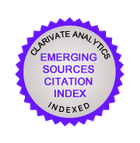VIRULENCE OF APPLE SCAB PATHOGEN POPULATION IN BELARUS
Abstract
About the Authors
Z. A. KazlouskayaBelarus
D.Sc. (Agricultural), Professor
T. A. Hashenka
Belarus
Ph.D. (Agricultural)
Yu. G. Kandratsenak
Belarus
Ph. D. (Agricultural)
References
1. Vavilov N.I. Immunitet rasteniy k infektsionnym zabolevaniyam [Immunity of plants to infectious diseases]. Moscow, Science Publ., 1986. 520 p.
2. Van der Plank J.E. Disease resistance in plants. Academic Press, New York, 1968. 206 p. (Russ. ed.: Van der Plank, Ya. Ustoychivost’ rasteniy k boleznyam. Moscow, Kolos Publ., 1972. 253 p.
3. Dorozhkin N.A., Bondar’ L.V., Konovalova N.A. Virulentnost’ shtammov vozbuditelya parshi yabloni [Strains virulence of scab pathogen of apple]. Mikologiya i fitopatologiya [Mycology and Phytopathology], 1979, no. 5, pp. 401–404.
4. Gashenko T.A., Kondratenok Yu.G., Kozlovskaya Z.A. Virulentnost’ shtammov Venturia inaequalis [Venturia in-aequalis strains virulence]. Sovremennye tekhnologii sel’skokhozyaystvennogo proizvodstva: sbornik nauchnykh statey po materialam XVII Mezhdunarodnoy nauchno-prakticheskoy konferenii (Grodno, 14 marta 2014 g.) [Modern technologies of agricultural production: collection of scientific articles on the materials of the XVII International scientific and practical conference (Grodno, March 14, 2014)]. Grodno, 2014, pp. 192–194.
5. Boone D.M., Keitt G.W. Venturia inaequalis (Cke.) Wint. XII. Genes controlling pathogenicity of wild-type lines. Phytopathology, 1957, vol. 47, no. 7, pp. 403–409.
6. Williams E.B., Shay J.R. The relationship of genes for pathogenicity and certain other characters in Venturia Inaequalis (Cke.) Wint. Genetics, 1957, vol. 42, no. 6, pp. 704–711.
7. Bagga H.S., Boone D.M. Genes in Venturia inaequalis controlling pathogenicity to crabapples. Phytopathology, 1968, vol. 58, no. 8, pp. 1176–1182.
8. Williams E.B., Kuc J. Resistance in malus to Venturia inaequalis. Annual Review of Phytopathology, 1969, vol. 7, pp. 223–246. doi: 10.1146/annurev.py.07.090169.001255.
9. Dayton D.F., Williams E.B. Additional allelic genes in Malus for scab resistance of two reaction types. Journal of the American Society of Horticultural Science, 1970, vol. 95, no. 6, pp. 735–736.
10. Sedov E.N., Zhdanov V.V. Ustoychivost’ yabloni k parshe: sorta i selektsiya [Resistance of apple to scab: varieties and breeding]. Orel: Priokskoe Book Publisher, 1983. 114 p. (In Russian).
11. Palmiter D.H. Variability in monoconidial cultures of Venturia inaequalis. Phytopathology, 1934, vol. 24, no. 1, pp. 22–47.
12. Schmidt M. Ventura inaequalis (Cooke) Aderhold. V. Weitere Untersuchungen iiber die aufverschiedenen Baumen lebenden Populationen des Apfelschorfes. Gartenbauwissenschaft, 1936, vol. 10, pp. 422–427.
13. Julien J.B., Spangelo L.P.S. Physiological races of Venturia inaequalis. Canadian Journal of Plant Science, 1957, vol. 37, no. 2, pp. 102–107. doi: 10.4141/cjps57-012.
14. Rudloff C.F. Venturia inaequalis (Cooke) Aderhold. III. Zur Formenmannigfaltigkeit des Pilzes. Gartenbauwissenschaft, 1934, vol. 9, pp. 105–119.
15. Keitt G.W., Langford M.H. Venturia inaequalis (Cke.) Wint. I. A groundwork for genetic studies. American Journal of Botany, 1941, vol. 28, no. 9, pp. 805–820. doi: 10.2307/2436667.
16. Dorozhkin N.A., Bondar’ L.V., Konovalova N.A. Agressivnost’ shtammov vozbuditelya parshi yabloni v Belarusi [Strains aggressiveness of scab pathogen of apple in Belarus]. Plodovodstvo: mezhvedomstvennyy tematicheskiy sbornik [Fruit: an inter-ministerial thematic collection]. Minsk, 1977, no. 3, pp. 125–131. (In Russian).
17. Bondar’ L.V., Konovalova N.A. Vnutrividovaya neodnorodnost’ Venturia inaequalis (Cooke) Wint. – vozbuditelya par-shi yabloni [Intraspecies heterogeneity of Venturia inaequalis (Cooke) Wint. – apple scab pathogen]. Materialy respublikanskoy konferentsii po zashchite rasteniy [Materials of the republican conference on plant protection]. Minsk, 1975, pp. 68–70.
18. Bondar’ L.V. Sravnitel’noe izuchenie populyatsii vozbuditelya parshi yabloni po morfologicheskim priznakam [Comparative study of populations of apple scab pathogen on morphological properties]. Zashchita rasteniy: sbornik nauchnykh trudov [Plant Protection: a collection of scientific papers]. Minsk, 1988, no. 13, pp. 21–25. (In Russian).
19. Dichkovskaya V.S. Kul’tural’no-morfologicheskie svoystva vozbuditelya parshi yabloni Venturia inaequalis (Cooke.) Wint. (konidial’naya stadiya Fusicladium dendriticum (Wallr.) Fuck.) [Culture and morphological properties of apple scab pathogen Venturia inaequalis (Cooke.) Wint. (Conidial stage Fusicladium dendriticum (Wallr) Fuck.)] Itogi i perspektivy razvitiya plodovodstva i ovoshchevodstva: materialy mezhdunarodnoy nauchno-prakticheskoy konferentsii, g. Gorki, 21–23 avgusta 2001 g. [Results and prospects of the development of fruit and vegetable growing: materials of the international scientific-practical conference, Gorki, 21-23 August 2001]. Gorki, 2001, pp. 181–185. (In Russian).
20. Komardina V.S. Osobennosti kul’tural’no-morfologicheskikh priznakov vozbuditelya parshi Venturia inaequalis (Coock.) Wint. (konidial’naya stadiya Fusicladium dendriticum (Wallr.) Fuck.), vydelennykh iz sadov razlichnykh tipov [Peculiarities of culture and morphological characteristics of scab pathogen Venturia inaequalis (Coock.) Wint. (Conidial stage Fusicladium dendriticum (Wallr) Fuck), identified from different types of gardens]. Zashchita rasteniy: sbornik nauchnykh trudov [Plant Protection: a collection of scientific papers]. Minsk, 2006, no. 30, pt. 2, pp. 121–129. (In Russian).
21. Kozlovskaya Z.A., Gashenko T.A. Vnutrividovaya neodnorodnost’ Venturia inaequalis – vozbuditelya parshi yabloni [Intraspecies heterogeneity of Venturia inaequalis - apple scab pathogen]. Vestnik Belorusskoy gosudarstvennoy sel’skokhozyaystvennoy akademii [Bulletin of the Belarusian State Agricultural Academy], 2009, no. 4, pp. 97–100. (In Russian).
22. Gaiii P., Broggini G.A.L., Gessler C., Patocehi A. The Rvi15 (Vr2) apple scab resistance locus contains three TIRNBS-LRR genes. Molecular Plant Microbe Interactions, 2010, vol. 23, no. 5, pp. 608–617. doi: 10.1094/MPMI-23-5-0608.
23. Parisi L., Lespinasse Y., Guillaumes J., Kruger J. A new race of Venturia inaequalis virulent to apples with resistance due to the Vf gene. Phytopathology, 1993, vol. 83, no. 5, pp. 533–537. doi:10.1094/Phyto-83-533.
24. Bus V.G.M., Rikkerink E.H.A., Weg van de W.E., Rusholme R.L., Gardiner S.E., Bassett H.C.M., Kodde L.P., Parisi L., Laurens F.N.D., Meulenbroek E.J., Plummer K.M. The Vh2 and Vh4 scab resistance genes in two differential hosts derived from Russian apple R12740-7A map to the same linkage group of apple. Molecular Breeding, 2005, vol. 15, no. 1, pp. 103–116. doi: 10.1007/s11032-004-3609-5.
25. Benaouf G., Parisi L. Genetics of host-pathogen relationships between Venturia inaequalis races 6 and 7 and Malus Species. Phytopathology, 2000, vol. 90, no. 3, pp. 236–242. doi: 10.1094/PHYTO.2000.90.3.236.
26. Kozlovskaya Z.A. Selektsiya yabloni v Belarusi [Apple breeding in Belarus]. Minsk, Belarusian Science Publ., 2015. 457 p. (In Russian).
27. Shay J.R., Hough L.F. Evalution of apple sead resistance in selections of Malus. American Journalof Botany, 1952, vol. 39, no. 4, pp. 288–297.



































